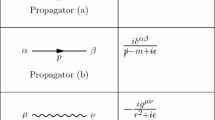Abstract
In General Relativity, the graviton interacts in three-graviton vertex with a tensor that is not the energy-momentum tensor of the gravitational field. We consider the possibility that the graviton interacts with the definite gravitational energy-momentum tensor that we previously found in the G 2 approximation. This tensor in a gauge, where nonphysical degrees of freedom do not contribute, is remarkable, because it gives positive gravitational energy density for the Newtonian center in the same manner as the electromagnetic energy-momentum tensor does for the Coulomb center. We show that the assumed three-graviton vertex does not lead to contradiction with the precession of Mercury’s perihelion. In the S-matrix approach used here, the external gravitational field has only a subsidiary role, similar to the external field in quantum electrodynamics. This approach with the assumed vertex leads to the gravitational field that cannot be obtained from a consistent gravity equation.
Similar content being viewed by others
References
S. Weinberg, Gravitation and Cosmology: Principles and Applications of the General Theory of Relativity (Wiley, New York, 1972; Mir, Moscow, 1975).
A. Einstein, Ann. Phys. 49, 769 (1916).
J. Cohn, Int. J. Theor. Phys. 2, 267 (1969).
C. W. Misner, K. S. Thorne, and J. A. Wheeler, Gravitation (Freeman, San Francisco, 1973; Mir, Moscow, 1977).
W. E. Thirring, Ann. Phys. (N.Y.) 16, 96 (1961).
A. A. Logunov, Part. Nucl. 29(1), 1 (1998); A. A. Logunov, The Theory of Gravitational Field (Nauka, Moscow, 2000) [in Russian]].
A. I. Nikishov, gr-qc/9912034; Part. Nucl. 32, 5 (2001).
Yu. Baryshev, gr-qc/9912003.
H. Dehnen, H. Hönl, and K. Westpfahl, Ann. Phys. (Leipzig) 6(7), 370 (1960).
Y. Iwasaki, Prog. Theor. Phys. 46, 1587 (1971).
M. J. Duff, Phys. Rev. D 7, 2317 (1973).
R. P. Feynman, F. B. Moringo, and W. G. Wagner, Feynman Lectures on Gravitation (Addison-Wesley, Reading, 1995).
J. Schwinger, Particles, Sources, and Fields (Addison-Wesley, Reading, 1970; Mir, Moscow, 1973).
T. Padmanabhan, gr-qc/0409089.
L. D. Landau and E. M. Lifshits, The Classical Theory of Fields (Nauka, Moscow, 1973; Pergamon Press, Oxford, 1975).
Author information
Authors and Affiliations
Additional information
Original Russian Text © A.I. Nikishov, 2006, published in Fizika Elementarnykh Chastits i Atomnogo Yadra, 2006, Vol. 37, No. 5.
Rights and permissions
About this article
Cite this article
Nikishov, A.I. On the phenomenological three-graviton vertex. Phys. Part. Nuclei 37, 776–784 (2006). https://doi.org/10.1134/S1063779606050042
Issue Date:
DOI: https://doi.org/10.1134/S1063779606050042



